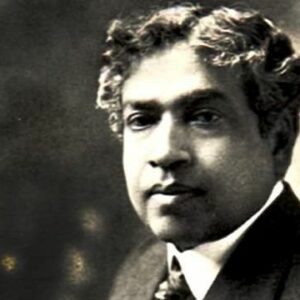Jagadish Chandra Bose was an Indian polymath who made significant contributions to the fields of botany, physics, archeology, and radio science. He was the first to prove that plants can experience pain and emotion. Because of the respect he gained from the Royal Institution in London, where the most famous British scientists of the day convened and debated their latest discoveries and ideas, Bose is regarded as India’s first modern scientist. He is recognized with laying the groundwork for experimental science in India, as well as being a pioneer in microwave optics technology. He created a galena receiver, one of the first examples of a lead sulphide photoconductive device. He had a strong interest in science since he was a child and aspired to be a doctor. However, due to a variety of factors, he was unable to pursue a career in medicine and instead changed his concentration to research. He was a motivated and hardworking individual who engaged himself in research and made his discoveries public for the advancement of science. He was not just a scientist, but also a gifted writer who established the standard for Bengali science fiction.
Childhood and Adolescence
Bhagawan Chandra Bose, a Brahmo Samaj leader and assistant commissioner, had a son named Jagadish Chandra Bose. Before learning English, his father wanted him to acquire the vernacular language and become acquainted with his own culture. As a result, little Jagadish was sent to a vernacular school, where he was surrounded by students of many faiths and communities. The youngster was profoundly affected by his interactions with a variety of people who were not prejudiced in any way.
He began his education at the Hare School in 1869 before transferring to St. Xavier’s School in Kolkata. In 1875, he enrolled at St. Xavier’s College, where he met Jesuit Father Eugene Lafont, who instilled in him a strong interest in the sciences.
He planned to go to England to study for the Indian Civil Service after getting his bachelor’s degree from the University of Calcutta in 1879. However, he changed his mind and chose to pursue a career in medicine. This strategy, too, did not suit him, and he had to reconsider his options once more.
Finally, he chose Natural Science as his major and was accepted into Christ’s College, Cambridge. He earned a BSc from the University of London in 1884 after completing his Natural Science Tripos at the college.
At Cambridge, Bose had the honor of being taught by great professors such as Francis Darwin, James Dewar, and Michael Foster. He also met Prafulla Chandra Ray, a fellow student with whom he became fast friends.
Career of Jagadish
On Lord Ripon’s request to the Director of Public Instruction, he was appointed as an officiating professor of physics in Presidency College upon his return to India in 1885. Bose was a victim of prejudice in his first work since his remuneration was set at a considerably lower level than that of British professors. Bose refused to accept the salary as a protest and taught at the college for three years without being paid.
The Director of Public Instruction and the Principal of the Presidency College made him permanent after some time and paid him his entire salary for the preceding three years. J.C. Bose possessed such a personality.
There were other more difficulties at the college. The college lacked a proper laboratory and was unsuitable for doing innovative research. Bose paid for his research out of his own pocket.
He experimented with Hertzion waves in India beginning in 1894 and generated the shortest radio waves of 5mm. In 1895, he conducted the first communication experiments, making him a multimedia communication pioneer.
In May 1895, he submitted his first scientific article to the Asiatic Society of Bengal, titled “On the Polarization of Electric Rays by Double Reflecting Crystals.” In 1896, his articles were published by the Royal Society of London.
In 1896, he met Marconi, who was also working on a wireless signaling experiment, and together they constructed the “iron-mercury-iron coherer with telephone detector,” which they presented before the Royal Society in 1899.
He was also a biophysics pioneer, being the first to argue that plants, like humans, can experience pain and understand loving.
He was also a writer, and in 1896, he published ‘Niruddesher Kahini,’ the first major work in Bengali science fiction. Later, the story was translated into English.
Major Projects of Jagadish
Jagadish Chandra Bose was a polymath who made an unmistakable mark in a variety of subjects. He devised the crescograph, which uses a system of clockwork gears to measure plant development. He is also credited with developing the first wireless detecting gadget, which he never attempted to patent himself.
Achievements & Awards
In appreciation of his services to science, he was named Companion of the Order of the Indian Empire in 1903 and Companion of the Order of the Star of India in 1912.
Personal History and Legacy
In 1887, he married Abala, the daughter of Brahmo reformer Durga Mohan Das. She was a well-known feminist in her own right, and she was a staunch supporter of her husband’s busy scientific career.
At the age of 78, he died in 1937. The Indian Botanic Garden of Acharya Jagadish Chandra Bose is named after this remarkable scientist.
Estimated Net Worth
Jagadish is one of the wealthiest inventors and one of the most well-known inventors. Jagadish Chandra Bose has a net worth of $1.5 million, according to Wikipedia, Forbes, and Business Insider.
Trivia
This outstanding Indian scientist was recently recognized by IEEE in the United States as one of the pioneers in radio discovery.


